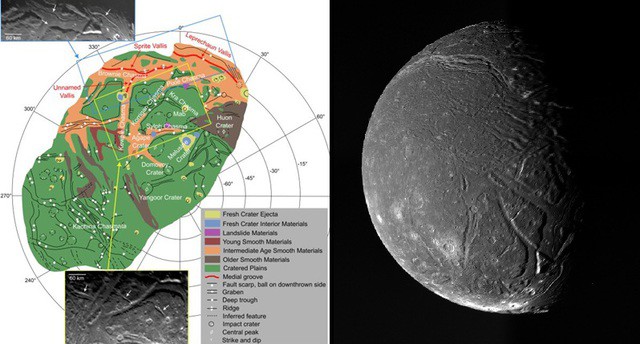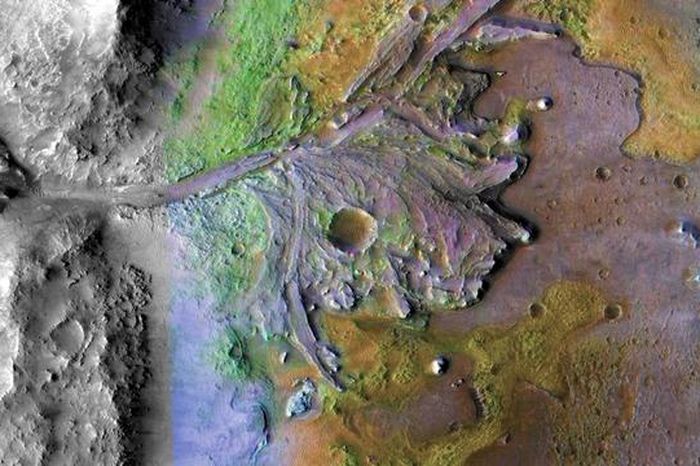Entrance to the world of alien life revealed in Ariel?
Ariel is Uranus' fourth largest moon, and has recently emerged as one of the potential targets for the search for alien life.
But there's a big catch: The place scientists expect life to exist on this cold, distant world is the potential underground ocean it might be hiding. Accessing an alien underground ocean is extremely difficult.
Analyzing data from NASA's Voyager spacecraft, a research team led by planetary geologist Chloe Beddingfield from the Johns Hopkins University Applied Physics Laboratory (USA) found a solution.

Map of some geological features on Ariel's surface and images taken by NASA's spacecraft of this moon - Photo: NASA/JOHN HOPIKINS UNIVERSITY
According to Science Alert, Ariel's underground ocean, if it exists, is also surrounded by a thick layer of ice.
Meanwhile, future missions will only be able to send small exploration devices there, which will have difficulty digging through the ice crust that can be tens of kilometers thick to reach the underground ocean.
So we need to take advantage of natural structures.
Ariel's surface is full of deep abysses, which future missions should target, because they could contain sediments that have erupted from below, according to Dr. Beddingfield and his colleagues. These include carbon dioxide ice and other carbonaceous deposits that could be the result of chemical processes taking place inside the moon.
If so, the canyons revealed by Voyager 2 data could be the "entrance" to life we hope for, since these types of sediments can reveal biological processes.
Additionally, the materials ejected inside the canyons may also reflect the chemical composition of the ocean and provide more details about Ariel's internal structure and how geologically active it is, if at all.
The abysses on Ariel's surface are fascinating, containing many "young" geological features that scientists hope may reflect a vibrant world operating within.
Ariel and other moons of Uranus such as Oberon, Titania, Miranda. are expected to have a fairly large underground ocean inside and have had life for a long time.
A US-UK-German study led by NASA's Jet Propulsion Laboratory (JPL) even suggests that fish may be swimming inside these oceans, as well as another potential underground ocean inside Uranus itself.
Voyager 2 only flew by Uranus, so the data it sent back to Earth about the planet and its moons—including Ariel—was limited. However, NASA has launched another mission called the Uranus Orbiter and Probe specifically for these celestial bodies.
You should read it
- The moon has a life expectancy of about 4.51 billion years - bigger than we think and so does life
- 50 images of Saturn's Enceladus moon - where life can exist (Part 1)
- 50 images of Saturn's Enceladus moon - where life can exist (Part 2)
- The Voyager 1 spacecraft sent signals to Earth for the first time in 5 months
- Bacteria on Earth live easily on Moon Enceladus
- Impressive series that Cassini captured before 'suicide'
- NASA successfully sent a software update to Voyager 2 from a distance of 19.9 billion km
- The Voyager 1 spacecraft resumes sending technical updates back to Earth
May be interested
- NASA robot enters the alien 'river of life'
 nasa's curiosity rover will enter an area that has never been explored and may hide alien creatures - ancient or alive.
nasa's curiosity rover will enter an area that has never been explored and may hide alien creatures - ancient or alive. - The Russian astronaut announces to find extraterrestrial life on the ISS Space Station
 the russian astronaut announced finding extraterrestrial life on the iss space station, only this discovery is a little less interesting than the hollywood movies we still see.
the russian astronaut announced finding extraterrestrial life on the iss space station, only this discovery is a little less interesting than the hollywood movies we still see. - NASA is about to announce the discovery of aliens?
 anonymous, the most notorious hacker group in the world has just posted a video on youtube and a post on the official site confirmed that nasa, the us aerospace agency, is preparing to publish findings of life on the ground. fine.
anonymous, the most notorious hacker group in the world has just posted a video on youtube and a post on the official site confirmed that nasa, the us aerospace agency, is preparing to publish findings of life on the ground. fine. - Is the 'alien skeleton' found in Peru true?
 join us to find out if the alien skeleton found in peru is real or not!
join us to find out if the alien skeleton found in peru is real or not! - If people 'occupy' the Sun 2.0 system, how different is life there from Earth?
 scientists at nasa have discovered 7 planets in the solar system 2.0 - trappist-1 is about the same size as the earth and is located in a region that can sustain life. assuming these planets can really sustain life, what will life on it be like?
scientists at nasa have discovered 7 planets in the solar system 2.0 - trappist-1 is about the same size as the earth and is located in a region that can sustain life. assuming these planets can really sustain life, what will life on it be like? - Alienware Area-51 m17x: laptop 'alien'
 the technology world is no stranger to 'alien' laptops (laptops) from alienware. the latest model, the area-51 m17x, is no exception, it also sits on the throne of the fastest and most powerful laptop available.
the technology world is no stranger to 'alien' laptops (laptops) from alienware. the latest model, the area-51 m17x, is no exception, it also sits on the throne of the fastest and most powerful laptop available. - Little is known about Steve Jobs' 'extraordinary' life
 steve jobs has become a legend in the world of technology. his life has experienced many ups and downs with many events that now this mysterious curtain is gradually revealed.
steve jobs has become a legend in the world of technology. his life has experienced many ups and downs with many events that now this mysterious curtain is gradually revealed. - 'Sudden death', the alien hunting ship still had time to leave behind its treasure
 nasa said that the alien hunter ingenuity has not really slept peacefully after 3 months of saying goodbye to humanity.
nasa said that the alien hunter ingenuity has not really slept peacefully after 3 months of saying goodbye to humanity. - NASA revealed the first studies of the planet's outer atmosphere
 nasa revealed the first studies of the atmosphere of seven earth-like planets, the area where life exists. invite you to consult!
nasa revealed the first studies of the atmosphere of seven earth-like planets, the area where life exists. invite you to consult! - Study and have fun with the game Toca Life World
 toca life world is not only considered a game, but also considered by many parents as an application for children to learn and play at the same time. below is the link to download toca life world apk from lmhmod and learn more about the characteristics, features as well as evaluate the health and safety level of the game.
toca life world is not only considered a game, but also considered by many parents as an application for children to learn and play at the same time. below is the link to download toca life world apk from lmhmod and learn more about the characteristics, features as well as evaluate the health and safety level of the game.










 Elon Musk's SpaceX Era Could Cause Aviation Disasters
Elon Musk's SpaceX Era Could Cause Aviation Disasters Japan successfully launched the world's first wooden satellite into space.
Japan successfully launched the world's first wooden satellite into space. An ancient asteroid once collided with and 'flipped' Jupiter's moon Ganymede
An ancient asteroid once collided with and 'flipped' Jupiter's moon Ganymede The 5 largest aircraft in the world are dominating the skies
The 5 largest aircraft in the world are dominating the skies Mars has a huge water ocean – but deep underground
Mars has a huge water ocean – but deep underground Admire a rare direct view of an exoplanet very similar to Jupiter
Admire a rare direct view of an exoplanet very similar to Jupiter